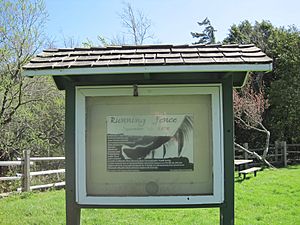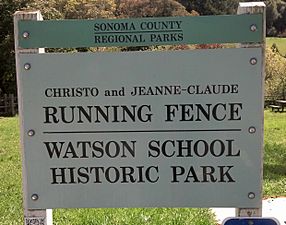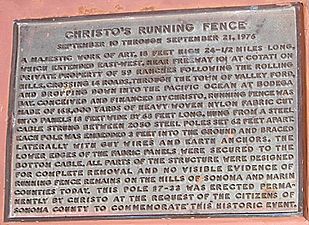Running Fence facts for kids
Quick facts for kids Running Fence |
|
|---|---|
 |
|
| Artist | Christo and Jeanne-Claude |
| Year | September 10, 1976 |
| Type | Installation art |
Running Fence was an installation art piece by Christo and Jeanne-Claude, which was completed on September 10, 1976. The art installation was first conceived in 1972, but the actual project took more than four years to plan and build. After it was installed, the builders removed it 14 days later, leaving no visible trace behind.
Contents
The Installation
The art installation consisted of a veiled fence 24.5 miles (39.4 km) long extending across the hills of Sonoma and Marin counties in northern California, United States. The 18-foot (5.5 m) high fence was made of 200,000 square meters (2,222,222 square feet) of heavy woven white nylon fabric, which created 2,050 panels, and was hung from steel cables by means of 350,000 hooks. The cables were supported by 2,050 steel poles (each: 6.4 meters / 21 feet long or 9 centimeters / 3.5 inches in diameter) embedded 1 meter (3 feet) into the ground, braced by steel guy wires (145 kilometers / 90 miles of steel cable), 14,000 earth anchors, and without any concrete.
The route of the fence began near U.S. Highway 101 and crossed 14 roads and the private property of 59 ranchers to reach the Pacific Ocean near Bodega Bay. The art project required 42 months of collaborative efforts, 18 public hearings, 3 sessions at the Superior Courts of California, and the drafting of an Environmental Impact Report (EIR); the required EIR for the piece was 450 pages long.
All expenses for the temporary work of art were paid by Christo and Jeanne-Claude through the sale of studies, preparatory drawings and collages, scale models and original lithographs.
The piece is said to have been partly inspired by fences demarcating the Continental Divide in Colorado.
Legacy
The piece is commemorated by historic markers at Watson School near Bodega, California and at State Route 1 in Valley Ford, California. In December 1976, the County Landmarks Commission, County of Sonoma designated the Valley Ford site (pole #7-33) as History Landmark #24.
The largest remaining intact and continuous section of the Running Fence hangs below the ceiling of the Rio Theater in Monte Rio, California.
Between April 1, 2010 through September 25, 2010, Christo and Jeanne-Claude: Remembering the Running Fence was on display at the Smithsonian American Art Museum. The exhibition comprised over 350 archival and related works and photographs, and visitors could touch the actual nylon fabric panels and steel poles from the original work of art.
Documentary
The piece was the subject of a 1978 documentary film Running Fence by Albert and David Maysles. The film includes scenes showing the local response to the project, which ranged from excitement to resentment and active protest. Several Californians including Expressionist painter Byron Randall protested the piece on the grounds of both land infringement and lack of artistic merit; however others appreciated the beauty of the work and in the end the project was completed.
Gallery
-
Sign at Watson School



